I don’t know about everyone else, but when I heard that they were bringing back the Elder Dragon creature type, I got really excited for a cycle of worthwhile commanders. As most of my readers likely know, Commander: the Format started out as Elder Dragon Highlander. You know, because there can be only one. When Wizards formally adopted the format, they changed its name to Commander. It’s less easily abbreviated than EDH was, but it does a better job of letting people know that their deck can be built around all sorts of legends, and not just Nicol Bolas and his kin.
The only playable one of the lot.
But the history is there, so there was a lot of pressure on the Dragonlords to be good commanders. They failed spectacularly to live up to the hype, at least for the type of Magic I personally find enjoyable. The heart of the matter seems to be that the Dragonlords, while powerful, aren’t interesting as Commanders! The elder dragons are definitely worth playing in your 99, but I just don’t think they do enough to take lead.
As I was musing over this dichotomy, I realized it might be valuable, for myself and others, to lay out what I look for in a good commander. After some quiet contemplation, here’s what I came up with.
Good commanders change the rules of the game
I wasn’t playing during Vanguard, but I think I probably would have enjoyed that format. As is, my favorite alternate format is Planechase, and it’s because I like it when there’s an interesting wrinkle that keeps people from playing the game on autopilot. One of the reasons I dislike tutor effects is that I find it boring when a game goes according to plan. The benefit of multiplayer Magic is that each extra person past the first adds another layer of complexity to the game. There’s another set of possibilities, and they’re usually harder to predict during a build. This type of Magic rewards people for quick thinking and for being able to come to unexpected solutions.
Alesha is just the slightest bit too slow to make reanimating this card typically a good play.
Dana and I had an example of this recently, albeit during a very Commander-esque game of Limited. Dana was facing down Ojutai, Soul of Winter with an Alesha, Who Smiles at Death on board, a Cunning Strike in her hand, and plenty of mana. She was stressed, because Ojutai is out of Cunning Strike range normally, and swinging into it seemed suicidal. I, however, noticed the Hooded Assassin in her graveyard, and when I brought it to her attention she saw the right play: Cunning Strike Ojutai, swing with Alesha, and reanimate Hooded Assassin for the kill. Our plan worked, and we ended up winning that round, despite having objectively weaker cards. We won because Alesha opened up our graveyard as a backup resource. That’s how Alesha, Who Smiles at Death changes the rules of the game.
Most of the other commanders I like have a similar effect, usually in such a fashion as to reward good deck design. Maelstrom Wanderer is my favorite commander, for example, because it rewards ramp by ensuring that you always have something to do with your mana. Endrek Sahr, Master Breeder rewards you for having sacrifice outlets and casting creature spells. Edric, Spymaster of Trest rewards other people for leaving you alone. Each one makes a subtle tweak to the landscape in such a way as to subtly tilt advantage in your favor.
Pay no attention to the elemental behind the curtain!
Okay, maybe it’s a bit much to call Maelstrom Wanderer “subtle.”
Good commanders have a repeatable effect
This brings us to element two of my commander evaluation: a repeatable effect. An interesting general offers a minor ability that’s not so powerful as to get immediately removed, but can add up to a tremendous amount of card advantage over the course of a game. Maelstrom Wanderer is an interesting example of this. While its main ability is a double cascade for cards costing seven or less, it only accesses this ability from the command zone. This leads to a situation where people let Maelstrom Wanderer stay on the board for long stretches of the game, because my opponents don’t want me getting the hardcore card advantage that the dual cascade offers. But! Maelstrom Wanderer has a static ability that lets my creatures all skip a turn, basically. It’s less powerful than the cascade, but it adds up over time. Dragonlord Kolaghan, meanwhile, has this ability, but without the cascade element there’s no reason to suffer it to live. Therefore, you’ll end up getting less advantage over the course of the game, and that’s boring.
It used to be you had to wait a turn cycle when your commander was a tutor.
As such, generally I look for things with “whenever” triggers. This is why I’m more excited about Anafenza, Kin-Tree Spirit than Sidisi, Undead Vizier. At first glance, Sidisi is super powerful, sure. The ability to have an unrestricted tutor for your Commander is definitely going to make some power players’ days. But personally, I’d rather the incidental advantage. Sidisi is going to draw a lot of aggro, and rightly so. The best way to build that deck involves giving yourself a lot of ways to kill Sidisi while leaving a body on the board, and that’s the type of play that gets noticed. That’s why I still stick with Endrek Sahr, Master Breeder as my monoblack commander of choice. He’s not as powerful as Sidisi, but you get more triggers without drawing the wrath of the table.
Of course, there’s always Geth, Lord of the Vault in the monoblack stable. His ability may not be a tutor, but it’s reusable so long as you have the mana, and monoblack is known for making a ton of it. This just goes to show you, a repeatable effect is not alone enough to keep a commander from earning the ire of a playgroup. Have you ever seen Geth fight over a Prophet of Kruphix? It gets ugly.
Good commanders have a reasonable casting cost
Do you know who makes for a bad commander? Akroma, Angel of Vengeance. (Akroma, Angel of Fury seems interesting, assuming you can cast it as a morph from the command zone.) Not only does she lack a particularly interesting set of abilities unless you’re trying to kill with commander damage (and, if so, she lacks a key point of power to do it right), but she casts eight mana. This is a ton. Even if your deck is just land and ramp (hard in white, but not impossible), you’re going to be spending a lot of resources getting your commander out. And I believe in playing your commander in Commander! I’m not usually running a commander for its color identity, since most color combinations have legendary creatures which do interesting things. When I want a powerful game of Magic in which I can play with nearly all the cards ever printed, I play Legacy. When I want to have fun, I play my commander and start doing weird shit.
3.5 Stars on Gatherer? Inconceivable!
That’s one of the reasons I’ve come around on Derevi, Empyrial Tactician. Initially, the purist in me recoiled at her ability to bypass the commander tax, but I’ve played with her a bunch now and I love two things about her. One, it’s impossible to keep her off the field. Usually when I play as her I’ll sacrifice her repeatedly to fog effects, but I never actually get around to casting her. It’s almost always the right play to hold her back until she’s needed, and I have the freedom to do this because as commanders go she’s a little weird. Two, she incentivizes the use of tap abilities. There aren’t a lot of commanders who make up for the slowness of tap abilities on your creatures, but she gives you a reason to muddle through.
It took me five tries before I finally remembered this dude’s set, let alone his name.
I say casting cost specifically, though, because one of my first commanders ever was Lord of Tresserhorn. I saw his four CMC and his potentially political cost and thought, “This guy will be great!” Of course, being young, I failed to account for how irritating it can be to have two creatures to sacrifice for your four-drop. And if I managed to get him out the first time, the second was always more of a pain in the ass. If your commander is hard to get on the battlefield, you’re probably not going to be able to take full advantage of it. That’s the one thing I find particularly admirable about Tiny Leaders.
Well, that and the way it’s sucking all the spikes out of Commander.
So, one by one, here’s why I dislike the new Elder Dragons:
Dragonlord Atarka
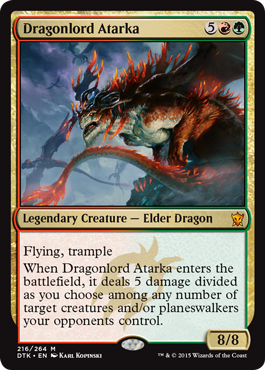
Would it really have been too powerful to let it go to the face?
Having a removal spell for your commander can be interesting. For example, in my Ulamog, the Infinite Gyre colorless deck, Ulamog is the commander because it’s very useful to be able to kill things. But Atarka’s numbers are all over the place. Five damage isn’t terrible, especially for a mana cheaper than Bogardan Hellkite, the clear inspiration for the card, but that seven mana casting cost means that you’re going to be dropping it later in the game, when five damage will have significantly less of an impact on the board. If it did seven damage that might be one thing, since that’s a commander-killer amount of damage, but five damage is going to be outclassed, especially when your opponents can see it coming. And ramping to it isn’t that useful, since it can’t go to the face when you run low on reasonable targets.
Dragonlord Dromoka
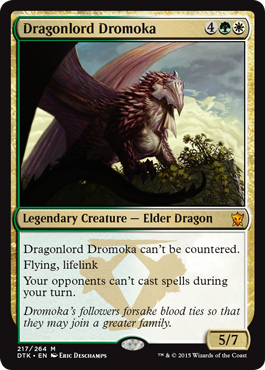
City of Solitude, plus a dude.
This card has super defensive abilities. It makes sense for flavor reasons, but this isn’t exactly a build-around card. The most interesting thing I can think to do with it would be to make a combat trick deck, but even that’s fairly reactive. Dromoka changes the rule of the game, but it just forces your opponents to play their end-step stuff on a different player’s turn. And that’s boring.
I mean, are counters really that much of a problem in your local meta that you want to run a commander that basically just says “your creatures can’t be countered”? And at six mana? No thank you.
Dragonlord Kolaghan
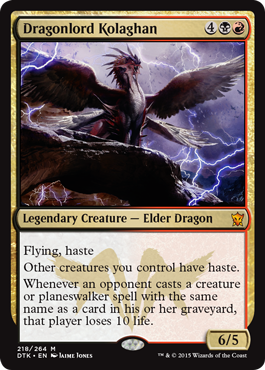
It’s absurd that the Rakdos Dragonlord costs more to cast than the Azorius one.
I believe I touched on this one above, but since the damage ability is basically untriggerable in Commander, this is just a shittier version of Maelstrom Wanderer. Perhaps that’s enough in a red black deck, but again it’s hindered by its casting cost. It would have been an interesting commander at four mana without the useless ability; as is, Rakdos decks aren’t really known for winning in the late game, haste or no.
Dragonlord Ojutai
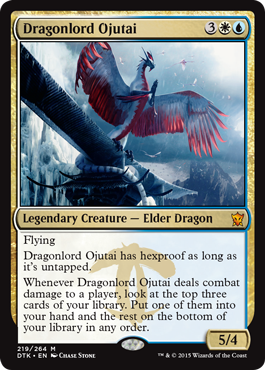
Whatever person keeps pushing the Azorius cards needs to come to the conclusion that blue and white don’t need any more help.
If there’s a more annoying ability than situational hexproof, it’s banding. Not exactly a high bar. This card was built for Standard, since you clearly want to be attacking with it, but it has to have a drawback to make up for the combat damage trigger. It’s repeatable, which is good, but a mini-Impulse once a turn doesn’t really scream “build around me!”
Dragonlord Silumgar
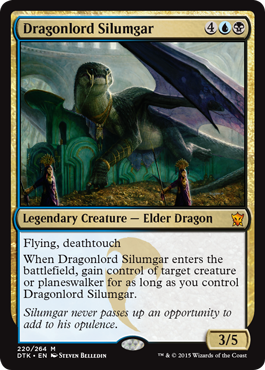
I don’t understand the flavor of this version losing hexproof but gaining deathtouch. If anything, it seems like his timeline is backwards.
Silumgar is the perfect end card, since it’s fairly clear he’s the best of the bunch, at least for Commander. Dimir likes to play jujitsu, and six mana fits with the ability, letting you snag something really good by virtue of it hitting the table when people are starting to make some big plays. But there’s something inherently boring about its ability. It comes into play, you get some incidental advantage from the best creature or planeswalker on the board, and then the control deck kills Silumgar and gets its shit back. Since the effect ends with Silumgar dies, it turns any attack on Silumgar into a two-for-one, and that’s a weak foundation for a deck.
Of course, I may be proven wrong by time, as I so often am. That’s what comes from having an opinion, every week, on things relating to Commander. But hopefully you can now see the framework I’m using for my evaluations. A lot of it happens on an intuitive level, but those are definitely the three big X factors.
Jess Stirba thinks Dragonlord is an idiotic title, for stupid genocidal beasts.

